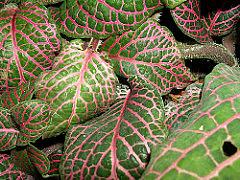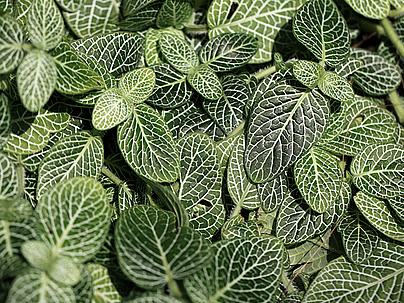The Nerve Plant (Fittonia albivenis) is a low-growing, herbaceous species with decorative foliage that is highly popular in enclosed terrariums, where it thrives due to its significant need for humidity. It features soft and pubescent branching with simple, oval, opposite leaves that have well-defined and contrasting white veins in the typical species. It blooms at the end of summer, producing upright spikes above the foliage, with small flowers gradually opening from the base towards the top, protected by green bracts.
The flowers have little ornamental significance, and many gardeners often remove them as soon as they appear. Currently, there are numerous cultivars of the nerve plant available in the market, featuring varied sizes, small leaves, and a multitude of combinations of green, red, pink, and even yellow hues. The leaves may also have smooth or wavy margins.
This beautiful foliage is an indoor plant par excellence. Its cultivation is relatively easy for experienced gardeners, making it an ideal choice for those who tend to overwater. In wide and low pots and containers, the rounded arrangement of this small and delicate foliage is well appreciated.
Decorate various areas of the house, avoiding locations with drafts, direct sunlight, and air conditioning. It is perfect for enclosed terrariums, combined with other plants, adding interest to the ensemble with its unique texture and color. In humid tropical climates or equally humid greenhouses, the nerve plant can also serve as ground cover for shaded areas.

It should be grown in diffuse or filtered light, in humus-rich, well-draining substrate, kept consistently moist but not waterlogged. Avoid exposing your nerve plant to direct sunlight, as this can cause burns on the leaves. It appreciates moderate temperatures and ambient humidity. In cold winter locations, it’s essential to protect it from temperatures below 15ºC (59ºF). Under excessive heat, extra care is needed with watering to meet the plant’s needs, as it does not tolerate drought. With insufficient water, the plant may collapse, appearing “fainted,” and can be revived by submerging the pot in water if not too late.
2 to 3 daily mistings may be necessary in dry weather. Yellowing lower leaves may indicate overwatering. Fertilize every 15 days in spring and summer with diluted fertilizers suitable for foliage plants. Encourage the densification of the nerve plant by pinching (removing terminal buds) during the growth phase and with tip pruning in summer for maintenance of the shape. Propagate through tip cuttings, which should have at least two nodes, from which new shoots will emerge. Cut the stems in spring and summer, and keep them in moist substrate until they root, which takes about three weeks.


